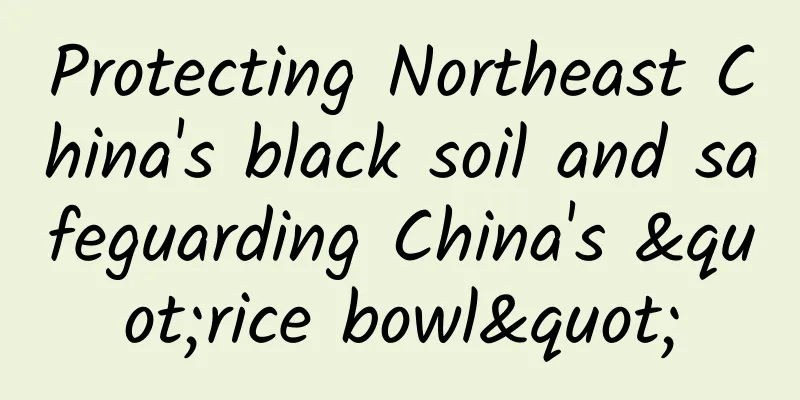Protecting Northeast China's black soil and safeguarding China's "rice bowl"

|
Produced by | Science Popularization China Author: Zhu Xuefeng (Institute of Applied Ecology, Chinese Academy of Sciences) Producer | China Science Expo As the saying goes, food is the first necessity of the people, and grain is the basis of the country's security. Grain is the key to human survival. So where does grain come from? Another saying gives the answer - all things grow from the soil, and where there is soil there is grain. Grain crops grow from the soil under our feet. Soil not only provides a home for plant seeds, but also provides nutrients for plant growth through the organic matter in the soil. The more organic matter in the soil, the darker the soil color, so well-developed black soil is rich in nutrients and is a very suitable soil type for growing food crops. Small sprouts sprouting in the black soil | Photo provided by Jie Hongtu There are four large tracts of fertile black soil in the world, one of which is located in my country’s three northeastern provinces and the Dongsi Meng area of Inner Mongolia, which is renowned as the country’s granary[1]. Today, one out of every three bowls of rice in my country comes from the black soil in Northeast China. 1 Where is the “fertility” of black soil? The fertility of black soil depends on soil organic matter. So how is soil organic matter formed? The soil, which seems to be "quiet" on weekdays, is actually surging with vitality all the time. In addition to seeds waiting to germinate, plant roots, and soil animals foraging, there is also a group of experts in producing soil organic matter living in the soil. They are the "indigenous residents" that are invisible to the naked eye but are everywhere - soil microorganisms, such as bacteria, fungi, etc. When dead branches and leaves fall to the ground, soil microorganisms will eat and decompose these plant residues. The plant residue fragments will be integrated into the soil organic matter to form new organic matter. The organic matter eaten by the microorganisms will become part of the microorganisms themselves. After the microorganisms die, they will be donated to the soil and become new soil organic matter [2]. Soil microorganisms play an important role in the decomposition of litter and plant residues and the formation of soil organic matter. Image provided by the author In this way, after generations of microorganisms feeding and decomposing, the foreign plant components are gradually transformed into nutrient-rich soil organic matter. Therefore, fallen leaves and branches are not heartless things. Under the processing of soil microorganisms, they can be turned into spring mud to help plant growth. Northeast my country is located in the temperate monsoon climate zone. It is warm and sunny in spring, hot and rainy in summer, and plants grow vigorously, supplying a large amount of fresh organic matter to the soil for microorganisms to process and produce organic matter. In winter, the temperature is low, and the microorganisms have to "take a winter break" in the dry and cold conditions. Plant residues that have not yet been decomposed and processed accumulate in the soil. Given the unique geographical location and climatic conditions in Northeast China, after winter and spring, the input of plant residues and the organic matter formed by microbial processing accumulate in the soil, making the soil more fertile and darker. 2 Black soil faces the dilemma of "neither black nor fertile" As can be seen from the above, a good soil environment and sufficient external food supply are the key to microbial production of soil organic matter. However, the traditional "intensive farming" has a great impact on the soil. Long-term tillage gradually destroys the structure of the black soil and displaces the microorganisms. Traditional farming causes a lot of disturbance to the soil. Image provided by Jie Hongtu In addition, the dead branches and leaves on the ground are collected or burned on the spot, resulting in the exposure of the soil surface. The surface lacks protection and cover, becoming vulnerable to wind and rain, with sand blowing all over the sky and soil erosion occurring frequently. At the same time, without the supply of dead branches and leaves and crop residues, microorganisms are short of food and have to "eat" the existing organic matter in the soil, resulting in a decrease in the soil organic matter content. If things go on like this, the originally fertile and strong black soil will become thin, malnourished, and gradually degrade, and the yield and quality of crops will gradually be threatened. Straw burning, bare land | Photo provided by Jie Hongtu 3 Pear Tree Mode - Save the Black Soil Faced with the severe problem of black soil degradation, scientists stayed in the black soil fields and after more than 10 years of exploration, they finally found an effective way to treat and repair the black soil, namely the conservation tillage technology - the pear tree model. The "Lishu Model" is a type of conservation tillage model and a protective utilization method of arable land with Chinese characteristics. When it was first created, it mainly focused on repairing the degraded black soil in Lishu County, Jilin Province. The no-till straw mulching conservation tillage technology system that was gradually developed in the area was named the "Lishu Model" by the Farmers' Daily in 2016. Corn fields covered with straw | Photo provided by Jie Hongtu Simply put, it means reducing soil tillage and not destroying the black soil structure. At the same time, all crop straw is spread on the surface to protect the soil from wind and rain and provide sufficient food for soil microorganisms. In this way, the wounds caused by excessive tillage gradually healed, the living environment of microorganisms improved, they ate well, lived well, resumed business, and participated in the production of soil organic matter. With a better soil structure, more organic matter, more nutrients in the soil, and a more shiny black soil, the quality of food will naturally be higher! Today, this conservation tillage technology has been widely applied and promoted in the black soil of Northeast China, and has achieved ideal results. The black soil has gradually regained its former black color, crops are growing stronger, and grain production is steadily increasing. After the implementation of conservation tillage, crops on the black soil in Northeast China are growing vigorously, and grain production is steadily increasing. Photo provided by Jie Hongtu Therefore, making good use of and protecting the black soil is a long and arduous project. The rice bowl of the Chinese people depends on the soil under their feet, and it needs to be carried by the Chinese people themselves! In order to make the rice in our bowls more and more abundant and fragrant, let us care about the health of the black soil, cherish the rice in our bowls, and contribute to the protection of the black soil! References [1] Wang Jingkuan, Xu Xiangru, Pei Jiubo, Li Shuangyi. (2021). Current status of cultivated land quality and opportunities and challenges in the black soil region of Northeast China. Soil Bulletin, 52(3), 695-701. [2] Liang Chao, Zhu Xuefeng. (2021). Overview of soil microbial carbon pump and carbon storage mechanism. Science China: Earth Sciences, 51(5), 680-695. Special Tips 1. Go to the "Featured Column" at the bottom of the menu of the "Fanpu" WeChat public account to read a series of popular science articles on different topics. 2. Fanpu provides a function to search articles by month. Follow the official account and reply with the four-digit year + month, such as "1903", to get the article index for March 2019, and so on. Copyright statement: Personal forwarding is welcome. Any form of media or organization is not allowed to reprint or excerpt without authorization. For reprint authorization, please contact the backstage of the "Fanpu" WeChat public account. |
Recommend
Google may force Android phones to encrypt in the future
Lollipop system encryption options According to f...
WWDC2015 animation effects
Every year, Apple holds a major conference. WWDC ...
5 Kotlin features Android developers need to know
[51CTO.com Quick Translation] It has always been ...
Air travel will not return to normal until 2024. How much damage will the epidemic cause to the aviation industry?
Air travel won't return to normal until 2024 ...
How to write a hit copy?
In fact, I am not very good at writing articles. ...
Zheng Chuanhua, the customer-attracting master, will give you a full course of "Million Customer Flow Explosion Camp" in 2021
Introduction to the full set of course resources ...
Why is the iPhone so popular? It’s not just about how easy it is to use, but also about the after-sales service.
When smartphones first entered the market, Steve ...
Analysis of domestic airport advertising business model
The essence of advertising is to inform a specifi...
Event promotion and operation: After I have done more than 100 fission events…
This is a very dry article, please click with cau...
Surface Pro 3 review: Not a tablet, but a convertible ultrabook
Microsoft's third-generation tablet computer, ...
Netflix apologizes for new film promotion, poster criticized for being too sexy!
Video streaming giant Netflix recently released a...
Ping An Life Insurance Policy Query: How can we make our website pages favored by search engines?
Website pages are not favored by search engines a...
How to avoid motion sickness? Check out this motion sickness rescue guide
Literature shows that about one-third of the worl...
Apple releases A13 Bionic processor: a big win over Snapdragon 855/Kirin 980
At the same time as the iPhone 11 was released, A...
Use celebrity quotes video accounts to earn over 10,000 yuan a month without any threshold
Internal course of the Youzi team: operate the ce...









